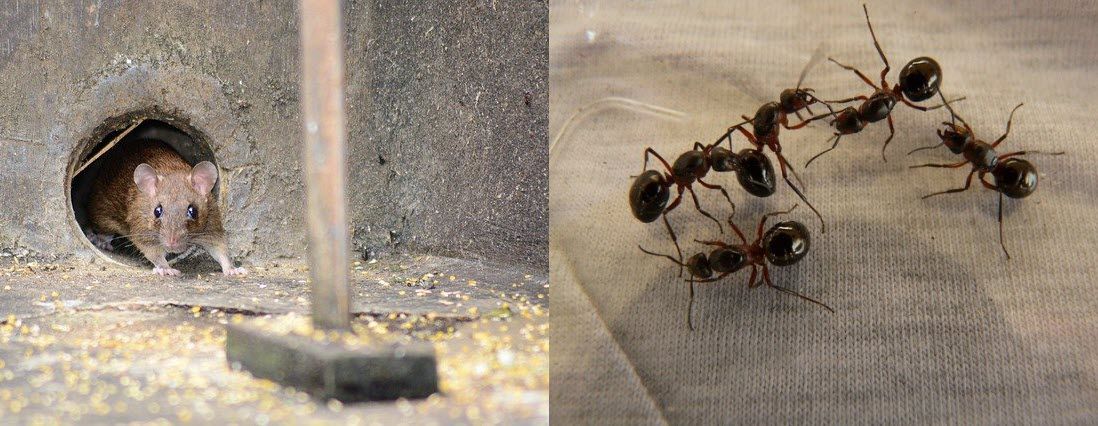Natural and mechanical pest deterents
Looking for natural rodent and ant deterrents? Well, you hit the jackpot here. Read on for natural, mechanical and other pest control tips.

Ants ain't welcome
Gone are the days when I'd whip out a can of some heavy-duty pest control and spray it around the house. Okay, not completely, I still use the long-distance wasp spray. Why? Those little buggers have a nasty sting, a bad attitude and will attack, provoked or not.
So, there are some nifty ways to control insects and mice around the house and garage.
Ants
Yes, you can buy ant traps or spray to keep the varmints outside where they belong. A simpler and safer solution is to run lemon juice along and around the opens they use to enter your domicile. I learned about this technique while living in Raleigh. We had a steady stream of what we call sugar ants; small and harmless but unwelcome, nonetheless. I'd give credit if I could remember who told me about taking a wedge of lemon and using it to block their path.

Step-by-step
- Watch to see where they are entering your house. Around doors and windows is a common point of entry. Baseboards under windows are another as are electrical outlets on exterior walls.
- Take your wedge of lemon and rub it on the surface around their point of entry. In my Raliegh example, they were sneaking in around the front door at the bottom. So, I ran the lemon along the door jam bottom and about two feet up each side.
FAQs
- Did it work? Beautifully!
- How long did it last? Until we sold the townhouse and moved nearly two years.
- Did it stain the surfaces? Not in this case or any other time I have used the approach. However, it is always a good idea to test it in an inconspicuous area first.
- How'd it smell? Lemon-fresh!
- What makes it work? Magic comes to mind. However, it is probably something mundane like the citrus breaking up the path the ants have created. I recall reading somewhere that ants leave a scent trail so the colony can use the path to the goodies.
Treat the mice to a sweet or pungent deterrent
A very effective method of mouse control is to step on them. Yes, you've got to fast, reflexively fast, because those little buggers can book it! Is this an acquired skill? Not that I know of. Something in my DNA equips me to see mice out of the corner of my eye as a gray blur and to step on them without thinking. The first time it happened, I knew instinctively a mouse caused the blur. The other DNA mouse control trait is an instinctive stomp. Gray blur, mouse, stomp, done.
Say what? One of my favorite examples is from our time in Dallas, TX. I was in the garage and caught the tell-tale flash. No sooner had I set the trap behind a stack of boxes than I caught the mouse. The other happened in Oxford, NC. I was heading for my workshop and noticed a critter had dragged an old towel to the corner. I flicked it over and several mice made a dash for it. My natural instinct took over and I got four of the six.

Stomping alternatives
Personally, I'd rather the vermin go live somewhere else. With that in mind, there are two techniques using all-natural goodies to keep them at bay.
Sweet
The first is to make a peppermint and water solution and paint it around their entrances and along their paths to it. You can use peppermint extract or, as I do, dissolve a peppermint stick in a glass of water. I prefer the softer variety, the kind you can make Baltimore lemonade with.

Step-by-step
1. Fill a glass with water, estimating how much area you want to cover.
2. Create a chunk of peppermint and drop it in the water.

3. Let it dissolve.

4. Paint it on!
FAQs
- Does it work? Yes, indeedy it does!
- How long does it last? Mice are more persistent than ants, so my experience is around two months.
- Why does it work? I guess mice are allergic to peppermint.
Pungent
The second is to use lavender to repel the fuzzballs. This is ideal for use under the hood of your car, which is where we use it. Lavender sachets are the best in terms of neatness and ease of use. You can also sprinkle lavender around their openings and along their paths. However, it doesn't last very long, being vulnerable to wind and rain.
I like this for cars because mice love nothing better than clambering into your engine compartment and making a cozy home in your cabin air filter. You know, the one that filters outside air before it enters the cabin? Uh-huh, my sentiments exactly. What nastiness is being sucked out of the mouse house and into your breathing air?
FAQs
- Does it work? Yup, the sachets especially.
- How long does it last? A typical winter so three months or so. As long as the lavender emits its lovely fragrance, it is effective.
- Should I add the lavender to the cabin air filter? I wouldn't, just get out near the filter.
- Can I drive with the sachets in place? If you place your individual sachets in secure areas away from direct contact with the engine or exhaust, it works fine. We've used long sachets before. Those we took off before driving. Be sure to check after you get home to be sure the sachets are there.
- Why does it work? Science, man! Mice don't like herbs from Provence?
*Bonus Content!!!
What is Baltimore lemonade? Well, I am glad you asked. It is a treat folks in Baltimore developed sometime in the 1800s, or so I think. I discovered it in the mid-1970s when I attended the Smithsonian's American Folklife Festival on the Capitol Mall in Washington, D.C.
Here's the recipe:
Ingredients
- Porous peppermint sticks, the kind that are about six inches long and has a crumbly texture. Candy canes won't work because they are too dense to suck the lemon juice through.
- Large lemons. You can also use oranges and smaller grapefruits. Any citrus will work so long as it is big enough to have the peppermint inserted.
Steps
- Roll your lemons on a hard surface to break up the pulp inside and release the juice. Moderate pressure is all you need, don't break the skin.
- Using a paring knife, cut a hole in the top of the lemon the diameter of the peppermint stick and about 2/3 the way through the fruit.
- Insert a peppermint stick and start sucking on it like a straw. You need to occasionally squeeze it to release more juice. The peppermint dissolves and flavors the juice.
Tip: Keep damp paper towels handy because this treat is sticky. Not in the cotton candy class, but sticky. As you squeeze the fruit, it begins to split around the opening.
Mouse traps
An effective mouse and vole control is the good old-fashioned mousetrap. You may say this is not a natural deterrent, which is correct; it is a manufactured device. However, you can bait it with all manner of natural goodies.
Cats can fulfill this purpose if you have a barn cat, but otherwise, I am referring to the universally recognizable wood and metal variety. My go-to trap is made by Victor. Simple and effective. The company offers a variant using a plastic bait holder, which I have used. However, I prefer the metal version.

Another point you may raise is that this approach terminates the rodent with extreme prejudice, rather than deters them. That is also correct. Unfortunately, given the fecundity (their proclivity to procreate) of rodents, deterrence only goes so far.
At some point, you need to thin the herd. One night, I went into the chicken run to secure the food and lock the coop. As I walked in, I was greeted with mice, lots of mice, sitting on every horizontal surface in the run. Maybe 100 of the buggers? And their beady little eyes seemed to be glowing. Zombie mice flashed to mind and just as fast, the mice booked it out of the run! I ramped up my mousetrap use and turned to another, unnatural threat eliminator, which you can read about next.
Just say no to sticky traps
While I generally have no compunction against controlling rodent populations with lethal means, I draw the line at sticky traps. I find these abhorrent in that they do not kill, they just trap the mouse/vole/whatever using adhesive. It is a lingering form of elimination and unnecessary. Use snap traps, live traps or anything other than these awful things. Of course, you may have a different view, in which case you can ignore this section.
The most fun you can have controlling pests
I want to close out with an unnatural but extremely satisfying method of mouse control, the Atlas Super Destroyer Super Gasser. These work very well on established mouse, vole and mole dens, something we grapple with all the time.

These beauties resemble the din-eh-mite Wile E. Coyote uses to try and catch the Roadrunner. They are about 6" long and an inch in diameter. In operation, they emit a yellowish cloud of smoke reminiscent of coal stoves. Seeing the smoke rise slowly up from the ground also reminds me of Centralia, PA and myriad zombie movie graveyard scenes. Very cool!
Note 1: These are for outside use only to avoid fires and super gassing yourself.
Note 2: Mice and voles are not specifically listed, I suspect from the volume of smoke produced. However, I have experienced success using them on the mouse dens around our chicken coop.
Step-by-step
- Locate the rodent hole.
- Test fit a Super Gasser to make certain you can push it fully into the tunnel.
- Insert one of the supplied fuses, light it and stick the fuse end into the hole first.
- Cover the opening with a solid, non-flammable item like a big rock, log, thick piece of scrap lumber, etc.
- Stand back and keep an eye open for smoke coming out of other openings to the den and to ensure nothing catches fire.
- After the smoke stops, fill in the opening with soil.
Tip 1: Keep pets and livestock clear while using the gassers. In our case, that's a pair of dogs and a brace of chickens.
Tip 2: Wear breathing protection, preferably a respirator. You don't want to be inhaling the smoke. Besides, it gives you an excuse to buy a slick respirator you can use for other things. These bad boys guarantee social distancing if worn in public! Here's the one I bought for rodent control!
Tip 3: If you do find other openings, mark them and fill them with soil after the gas dissipates.
Nature or chemistry - which controls best?
It is hard to beat natural pest controls. They are safe and do not use potentially harmful manufactured chemicals. So, why the coverage of the Super Gasser? Because it works underground where my chickens and pets cannot be impacted, it is effective, and as already mentioned, it's cool.
